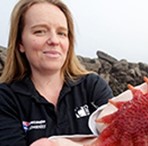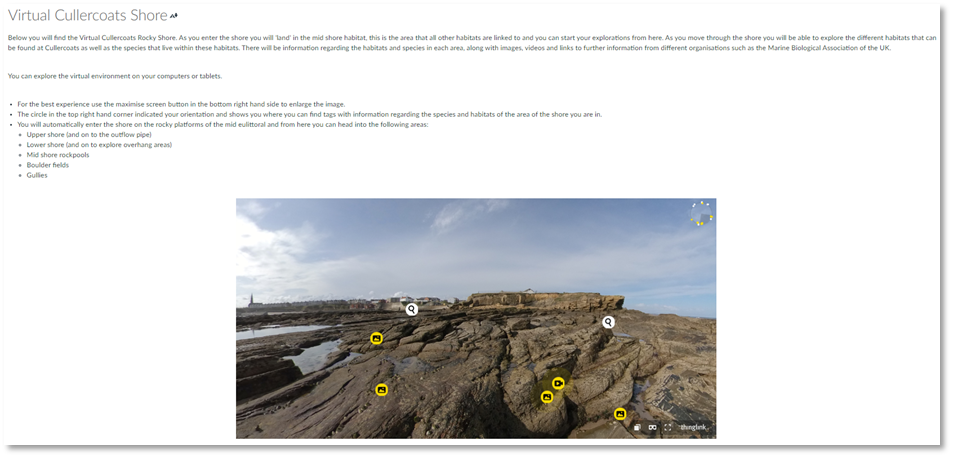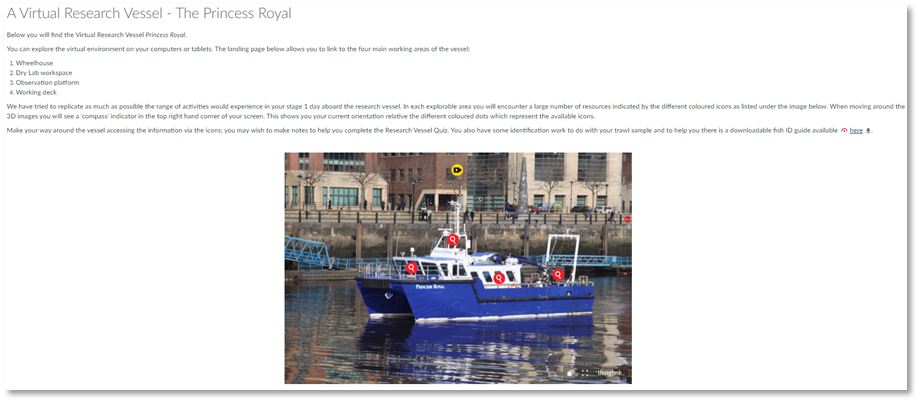Dr Heather Sugden, Dr Sara Marsham, and Dr Ben Wigham



School of Natural and Environmental Sciences
Faculty of Science, Agriculture and Engineering
What did you do?
Created virtual rocky shores for the modules MST1205 Marine Practical Skills 1 and MST2204 Research and Employability Skills and a virtual research vessel practical for all three stages of the Marine Science degree programmes to enable staff and students to still complete fieldwork.
Traditionally students are taken to the Dove Marine Laboratory and access the rocky shore at Cullercoats and also work onboard the Newcastle University vessel, the Princess Royal. They are introduced to different marine habitats and the different species that live there.
Students undertake a range of practical activities in these environments.
MST1205 is a 20 credit module with 10 credits in semester one and a further 10 credits in semester two with around 67 students.
MST2204 is also a 20 credit module with 10 credits each in semester one and two. There are 66 students on this module.


Who is involved?
- Dr Heather Sugden, Lecturer in Marine Biology
- Dr Sara Marsham, Senior Lecturer; Marine Sciences Degree Programme Director
- Dr Ben Wigham, Lecturer in Marine Biology; Research Vessel Manager
How did you do it?
A virtual shore and virtual vessel were created using a program called ‘Thinglink’.
Thinglink was investigated pre-lockdown in March and over the summer. Using a 360 degree camera, an environment was created in Thinglink to give students an immersive environment where they could interact with different content. This included image descriptions, text descriptions, videos, forms, quizzes, and voice recordings that can all be integrated into the base image. This content reflects what would have been delivered in the field.
Thinglink is straightforward to use but it is worth noting that it takes a fair amount of effort to get all the data required to build the environment.
It is also worth noting that a trial version only allows 1000 views before students will need to view the content on the Thinglink browser version rather than embedded into Canvas. Additional educational licenses can be bought that are not expensive.
Why did you do it?
Pre Covid 19 there were discussions about different types of technology and how these technologies enhanced the provision within delivery and how tablets could be incorporated as all SNES students now have tablets. With the move to online delivery, this accelerated how technologies could be used to deliver the field elements and for students not to miss out on this field learning.
The main purpose of these virtual 360 environments was to ensure students were still getting some element of the practical delivery and experience of the shore and vessel environment.
The virtual environments will also give context to the other content the students are learning. They will be able to link the learning to the real-life environment even through the digital platform.
Sara and Heather delivered the following presentation in the 2021 Art of the Possible week in July.
Does it work and Student Voice
The students engaged really well with the virtual fieldwork during synchronous online sessions and as non-synchronous online material. There was around 95% attendance at the first synchronous online session in both MST1205 and MST2204.
The feedback during the session was excellent with students really appreciating the effort that has been put into creating this for them.
They really liked that they could take their time and explore the virtual environments. They could read the materials then view the videos and images and really think about the material.
And some actually said they concentrated on the content more as it is possible they could have been joking around and not spending as much time on the content when out in the field.
With the content being available in Canvas, students can revisit the learning multiple times to get the best out of the experience and the learning available. This is evidenced by Microsoft Stream views continuing to rise after the event, extending the period of learning for students.
Feedback from students,
“I liked how they were all divided up because this makes them easier to break up and extract the relevant information from”
“I found it so useful that more in depth photos were taken because they highlighted things that I would most likely have missed if I was on the shore”
“thank you for the effort involved in setting up the shoreline”
Graduate Framework
This approach develops the following attributes:
- Engaged
- Critical Thinkers
- Curious
- Digitally capable
Staff can find out more about the Graduate Framework on the University intranet.
